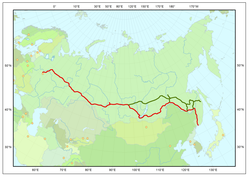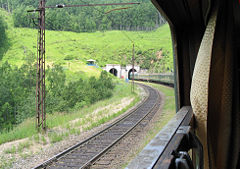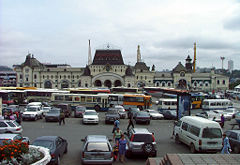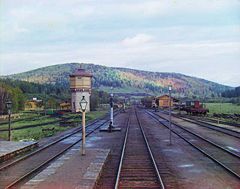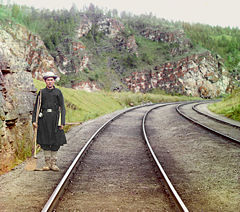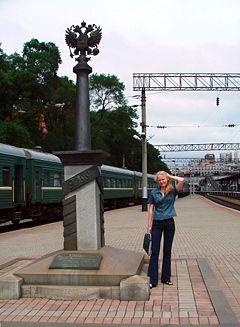Trans-Siberian Railway
2008/9 Schools Wikipedia Selection. Related subjects: Railway transport
The Trans-Siberian Railway or Trans-Siberian Railroad (Транссибирская магистраль, Транссиб in Russian, or Transsibirskaya magistral', Transsib) is a network of railways connecting Moscow and European Russia with the Russian Far East provinces, Mongolia, China and the Sea of Japan.
History
The original plans and funding for construction of a Trans-Siberian railway to connect the capital, St. Petersburg, with the Pacific Ocean port of Vladivostok, were approved by the Czar Alexander II in St. Petersburg. His son, the Czar Alexander III supervised the construction; the Czar personally appointed Sergei Witte Director of Railway Affairs in 1889. The Imperial State Budget spent 1 billion 455 million rubles from 1891 to 1913 on the railway construction, a record which was surpassed only by the military budget in World War I.
In March of 1891, the future Czar Nicholas II and Alexandra personally opened and blessed the construction of the Far East segment of the Trans-Siberian Railroad on their stop in Vladivistok, after visiting Japan at the end of their journey around the world. Nicholas II made records in his diary about his anticipation of travelling in the comfort of The Czar's Train across the unspoiled wilderness of Siberia. The Czar's Train was designed and built in St. Petersburg to serve as the main mobile office of the Czar and his staff for traveling across Russia.
The main route of the Trans-Siberian originates in St. Petersburg at Moskovsky Vokzal, runs through Moscow, Chelyabinsk, Omsk, Novosibirsk, Irkutsk, Chita, Blagoveshchensk and Khabarovsk to Vladivostok via southern Siberia and was built between 1891 and 1916 under the supervision of government ministers of Russia who were personally appointed by the Czar Alexander III and by his son, Czar Nicholas II. The additional Chinese Eastern Railway was constructed as the Russian-Chinese part of the Trans-Siberian railway, connecting Russia with China, and it was operated by a Russian staff and administration based in Harbin.
The Trans-Siberian railway is often associated with the main transcontinental Russian train that connects hundreds of big and small cities of the European and Asian parts of Russia. At 9,288 kilometres (5,772 miles), spanning eight time zones and taking several days to complete the journey, it is the third-longest single continuous service in the world, after the Moscow–Pyongyang (10267 km, 6380 mi) and the Kiev– Vladivostok (10267 km, 6380 mi) services, both of which also follow the Trans-Siberian for much of their routes. The route was opened by Tsarevich Nicholas Alexandrovitch of Russia after his eastern journey ended.
A second primary route is the Trans-Manchurian, which coincides with the Trans-Siberian as far as Tarskaya (a stop 12 km east of Karymskaya, in Chita Oblast), about 1,000 km east of Lake Baikal. From Tarskaya the Trans-Manchurian heads southeast, via Harbin and Mudanjiang in China's Northeastern Provinces (from where a connection to Beijing is used by one of Moscow–Beijing trains), joining with the main route in Ussuriysk just north of Vladivostok. This is the shortest and the oldest rail route to Vladivostok. Some trains split at Shenyang, China, with a portion of the service continuing to Pyongyang, North Korea.
The third primary route is the Trans-Mongolian, which coincides with the Trans-Siberian as far as Ulan Ude on Lake Baikal's eastern shore. From Ulan-Ude the Trans-Mongolian heads south to Ulaan-Baatar before making its way southeast to Beijing.
In 1991, a fourth route running further to the north was finally completed, after more than five decades of sporadic work. Known as the Baikal Amur Mainline (BAM), this recent extension departs from the Trans-Siberian line at Taishet several hundred miles west of Lake Baikal and passes the lake at its northernmost extremity. It crosses the Amur River at Komsomolsk-na-Amure (north of Khabarovsk), and reaches the Pacific at Sovetskaya Gavan.
Demand and design
In the late 19th century, the development of the Siberia was hampered by poor transportation links within the region as well as between Siberia and the rest of the country. Aside from the Great Siberian Route, good roads suitable for wheeled transport were few and far apart. For about five months of the year, rivers were the main means of transportation; during the cold half of the year, cargo and passengers traveled by horse-drawn sleds over the winter roads, many of which were the same rivers, now ice-covered.
The first steamboat on the Ob, Nikita Myasnikov's Osnova, was launched in 1844; but the early starts were difficult, and it was not until 1857 that steamboat shipping started developing in the Ob system in the serious way. Steamboats started operating on the Yenisei in 1863, on the Lena and Amur in the 1870s.
While the comparably flat Western Siberia was at least fairly well served by the gigantic Ob– Irtysh– Tobol– Chulym river system, the mighty rivers of Eastern Siberia — the Yenisei, the Upper Angara River (the Angara River below Bratsk was not easily navigable because of the rapids), and the Lena — were mostly navigable only in the north-south direction. An attempt to somewhat remedy the situation by building the Ob-Yenisei Canal was not particularly successful. Only a railroad could be a real solution to the region's transportation problems.
The first railroad projects in Siberia emerged after the completion of the Moscow-Saint Petersburg Railway in 1851. One of the first was the Irkutsk– Chita project, proposed by an American entrepreneur W. Collins and supported by Transport Minister Constantine Possiet with a view toward connecting Moscow to the Amur river, and consequently, to the Pacific Ocean. Siberia's governor, Nikolay Muravyov-Amursky, was anxious to advance the colonization of the Russian Far East, but his plans could not materialize as long as the colonists had to import grain and other food from China and Korea. It was on Muravyov's initiative that surveys for a railroad in the Khabarovsk region were conducted.
Before 1880, the central government had virtually ignored these projects, because of the weakness of Siberian enterprises, a clumsy bureaucracy, and fear of financial risk. Financial minister Count Egor Kankrin wrote:
The idea of covering Russia with a railroad network not just exceeds any possibility, but even building the railway from Petersburg to Kazan must be found untimely by several centuries.
By 1880, there were a large number of rejected and upcoming applications for permission to construct railways to connect Siberia with the Pacific but not eastern Russia. This worried the government and made connecting Siberia with central Russia a pressing concern. The design process lasted 10 years. Along with the route actually constructed, alternative projects were proposed:
- Southern route: via Kazakhstan, Barnaul, Abakan and Mongolia.
- Northern route: via Tyumen, Tobolsk, Tomsk, Yeniseysk and the modern Baikal Amur Mainline or even through Yakutsk.
According to a legend, the line originally had an unneeded 7 km loop, which was due to the fact that during planning, the Tsar accidentally had part of his finger in the way of plotting the route, and construction workers were too afraid of mentioning the mistake to the Tsar, resulting in them building the line including this "error". (Lonely Planet, Trans-Siberian Railway, first edition. This legend is more often told about the much earlier Moscow-Saint Petersburg Railway.)
Railwaymen fought against suggestions to save funds, for example, by installing ferryboats instead of bridges over the rivers until traffic increased. The designers insisted and secured the decision to construct an uninterrupted railway.
Unlike the rejected private projects, that intended to connect the existing cities demanding transport, the Trans-Siberian did not have such a priority. Thus, to save money and avoid collisions with land owners, it was decided to lay the road aside the existing cities. Tomsk was the largest city, and the most unfortunate, because the swampy banks of the Ob River near it was considered inappropriate for a bridge. The railway was laid 70 km to the south (instead crossing the Ob at Novosibirsk city), just a blind branch line connected with Tomsk, depriving the city of the prospective transit rail traffic and trade.
The railway was instantly filled to its capacity with local traffic, mostly wheat. Together with low speed and low possible weights of trains, it upset the promised role as a transit route between Europe and East Asia. During the Russian-Japanese war, the military traffic to the East almost disorganized the civic freight flow.
Construction
Full time construction on the Trans-Siberian Railway began in 1891 and was put into execution and overseen by Sergei Witte, who was then Finance Minister.
Similar to the First Transcontinental Railroad in the USA, Russian engineers started construction at both ends and worked towards the centre. From Vladivostok the railway was laid north along the right bank of the Ussuri River to Khabarovsk at the Amur River becoming the Ussuri railway.
In 1890, a bridge across the river Ural was built and the new railroad entered Asia. The bridge across the Ob River was built in 1898 and the small city of Novonikolaevsk, founded in 1883, metamorphosed into a large Siberian centre— Novosibirsk city. In 1898, the first train reached Irkutsk and the shores of Lake Baikal. The railroad ran on to the East, across the Shilka and the Amur rivers and soon reached Khabarovsk. The Vladivostok-Khabarovsk branch was built a bit earlier, in 1897.
Russian soldiers, as well as convict labourers from Sakhalin and other places were pressed into railway-building service. One of the largest challenges was the construction of the Circum-Baikal Railway around Lake Baikal, some 60 km (40 mi) east of Irkutsk. Lake Baikal is more than 640 km (400 mi) long and over 1,600 m (5,000 feet) deep. The line ended on each side of the lake and a special icebreaker ferryboat was purchased from England to connect the railway. In the winter sleighs were used to move passengers and cargo from one side of the lake to the other until the completion of the Lake Baikal spur along the southern edge of the lake. With the completion of the Amur River line north of the Chinese border in 1916, there was a continuous railway from Petrograd to Vladivostok that remains to this day the world's longest railway line. Electrification of the line, begun in 1929 and completed in 2002, allowed a doubling of train weights to 6,000 tonnes.
Effects
The Trans-Siberian Railway gave a great boost to Siberian agriculture, facilitating substantial exports to central Russia and Europe. It influenced the territories it connected directly, as well as those connected to it by river transport. For instance, Altai Krai exported wheat to the railway via the Ob River.
As Siberian agriculture began to export cheap grain towards the West, agriculture in Central Russia was still under economic pressure after the end of serfdom, which was formally abolished in 1861. Thus, to defend the central territory and to prevent possible social destabilization, in 1896, the government introduced the Chelyabinsk tariff break (Челябинский тарифный перелом), a tariff barrier for grain passing through Chelyabinsk, and a similar barrier in Manchuria. This measure changed the nature of export: mills emerged to create bread from grain in Altai, Novosibirsk and Tomsk, and many farms switched to butter production. From 1896 until 1913 Siberia exported on average 501,932 tonnes (30,643,000 pood) of bread (grain, flour) annually.
The Trans-Siberian line remains the most important transportation link within Russia; around 30% of Russian exports travel on the line. While it attracts many foreign tourists, it also gets considerable use from domestic passengers.
Today the Trans-Siberian Railway carries about 20,000 containers per year to Europe, including 8,300 containers from Japan. This is a fairly small amount, considering that for all means of transport combined Japan sends 360,000 containers to Europe per year. Thus, there is potential for growth, and the Russian Ministry of Transport planned to increase the number of containers shipped on the railway to 100,000 by the year 2005 and satisfy the passage and cargo needs of 120 trains per day. This required that stretches that were single track and formed a bottleneck would be made double track.
Passenger fares
The train has second class four-berth compartments (called "kupé") and first class two-berth compartments (called "spalny wagon" or "SV") and a restaurant car. One-way fares start at about US$250 in a four-berth sleeper or US$320 in a two-berth sleeper. Prices increase dramatically if additional stops are needed. Russian train tickets can be purchased only within the Russian Federation or in Finland. Tickets can be purchased no more than 45 days in advance. Many travel agencies can arrange to have tickets purchased by proxy, but the 45 day limit is strictly enforced.
Several European railway companies (notably Germany's Deutsche Bahn, Czech Railways, and Poland's Polskie Koleje Państwowe) sell tickets/reservations for long-distance domestic trains, since the German train reservation system is linked with their Russian counterpart system. Return tickets from Central Europe to Vladivostok and back can be as cheap as €230.00 with so called CityStar or Sparpreis Europa special offers. In addition a reservation supplement for long-distance trains is mandatory, the prices range between €30.00 to €60.00 each way for trains in four-berth sleeper on the Trans-Siberian railroad. Overall, buying tickets for Russian trains in Germany, the Czech Republic or Poland can be cheaper and easier (language-wise) than in Russia.
Routes
In general, the lower the train number the fewer stops it makes and therefore the faster the journey. Unfortunately, the train number makes no difference to the duration of border crossings.
Trans-Siberian line
A commonly used main line route is as follows. Distances and travel times are from the schedule of train No.002M, Moscow-Vladivostok.
- Moscow, Yaroslavsky Rail Terminal (0 km, Moscow Time).
- Vladimir (210 km, MT)
- Nizhny Novgorod (461 km, 6 hours, MT) on the Volga River. Its railroad station is still called by its old Soviet name Gorky, and is so listed in most timetables.
- Kirov (917 km)
- Perm (1,397 km, 20 hours, MT+2) on the Kama River
- Official boundary between Europe and Asia (1,777 km), marked by a white obelisk.
- Yekaterinburg (1,778 km, 1 day 2 h, MT+2) in the Urals, still called by its old Soviet name Sverdlovsk in most timetables.
- Tyumen (2,104 km)
- Omsk (2,676 km, 1 day 14 h, MT+3) on the Irtysh River
- Novosibirsk (3,303 km, 1 day 22 h, MT+3) on the Ob River
- Krasnoyarsk (4,065 km, 2 days 11 h, MT+4) on the Yenisei River
- Taishet (4,483 km), junction with the Baikal-Amur Mainline
- Irkutsk (5,153 km, 3 days 4 h, MT+5) near Lake Baikal's southern extremity
- Ulan Ude (5,609 km, 3 days 12 h, MT+5)
- Junction with the Trans-Mongolian line (5,622 km)
- Chita (6,166 km, 3 days 22 h, MT+6)
- Junction with the Trans-Manchurian line at Tarskaya (6,274 km)
- Birobidzhan (8,312 km, 5 days 13h), the capital of Jewish Autonomous Region
- Khabarovsk (8,493 km, 5 days 15 h, MT+7) on the Amur River
- Ussuriysk (9,147 km), junction with the Trans-Manchurian line and Korea branch
- Vladivostok (9,289 km, 6 days 4 h, MT+7), on the Pacific Ocean
Services to North Korea continue from Ussuriysk via:
- Primorsk (9,257 km, 6 days 14h, MT+7)
- Khasan (9,407 km, 6 days 19h, MT+7, border with North Korea)
- Tumangan (9,412 km, 7 days 10h, MT+6, North Korean side of the border)
- Pyongyang (10,267 km, 9 days 2h, MT+6)
There are many alternative routings between Moscow and Siberia. For example:
- Some trains would leave Moscow from Kazansky Rail Terminal instead of Yaroslavsky Rail Terminal; this would shave some 20 km off the distances, because it provides a shorter exit from Moscow onto the Nizhny Novgorod main line.
- One can take a night train from Moscow's Kursky Rail Terminal to Nizhny Novgorod, make a stopover in the Nizhny and then transfer to a Siberia-bound train
- From 1956 to 2001 many trains went between Moscow and Kirov via Yaroslavl instead of Nizhny Novgorod. This would add some 29 km to the distances from Moscow, making Vladivostok Kilometer 9,288.
- Other trains get from Moscow (Kazansky Terminal) to Yekaterinburg via Kazan.
- Between Yekaterinburg and Omsk it is possible to travel via Kurgan Petropavl (in Kazakhstan) instead of Tyumen.
- One can bypass Yekaterinburg altogether by travelling via Samara, Ufa, Chelyabinsk, and Petropavl; this was historically the earliest configuration.
Depending on the route taken, the distances from Moscow to the same station in Siberia may differ by several tens of kilometers.
Trans-Manchurian line
The Trans-Manchurian line, as e.g. used by train No.020, Moscow-Beijing follows the same route as the Trans-Siberian between Moscow and Chita, and then follows this route to China:
- Branch off from the Trans-Siberian-line at Tarskaya (6,274 km from Moscow)
- Zabaikalsk (6,626 km), Russian border town
- Manzhouli (6,638 km from Moscow, 2,323 km from Beijing), Chinese border town
- Harbin (7,573 km, 1,388 km)
- Changchun (7,820 km from Moscow)
- Beijing (8,961 km from Moscow)
The express train (No.020) travel time from Moscow to Beijing is just over six days.
There is no direct passenger service along the entire original Trans-Manchurian route (i.e., from Moscow—or anywhere in Russia-west-of-Manchuria—to Vladivostok via Harbin), due to the obvious administrative and technical ( gauge break) inconveniences of crossing the border twice. However, assuming sufficient patience and possession of appropriate visas, it is still possible to travel all the way along the original route, with a few stopovers (e.g. in Harbin, Grodekovo, and Ussuriysk). That would pass the following points from Harbin east:
- Harbin (7,573 km from Moscow)
- Mudanjiang (7,928 km)
- Suifenhe (8,121 km), the Chinese border station
- Grodekovo (8,147 km), Russia
- Ussuriysk (8,244 km)
- Vladivostok (8,356 km)
Trans-Mongolian line
The Trans-Mongolian line follows the same route as the Trans-Siberian between Moscow and Ulan Ude, and then follows this route to Mongolia and China:
- Branch off from the Trans-Siberian line (5,655 km from Moscow)
- Naushki (5,895 km, MT+5), Russian border town
- Russian–Mongolian border (5,900 km, MT+5)
- Sükhbaatar (5,921 km, MT+5), Mongolian border town
- Ulan Bator (6,304 km, MT+5), the Mongolian capital
- Zamyn-Üüd (7,013 km, MT+5), Mongolian border town
- Erenhot (842 km from Beijing, MT+5), Chinese border town
- Datong (371 km, MT+5)
- Beijing (MT+5)
Cultural importance
- The Trans-Siberian Railway is the theme for the Trans-Siberian Railway Panorama and 1900 Trans-Siberian Railway Fabergé egg.
- The Corto Maltese comic "Corto Maltese en Sibérie" has the Trans-Siberian Railway as part of the story that takes place in the Russian Revolutionary Period of the 20th Century.
- The cult film Horror Express starring Peter Cushing, Christopher Lee and Telly Savalas is set aboard the railway.
Future
Moscow intends to upgrade the line, as its technology is dated. Talks are being held to upgrade the line with Japanese Shinkansen makers, aimed at reducing end-to-end time from seven to 2–3 days, mostly for freight. Hopes are that there will be a large market for shipping goods from North Asia to Europe, being much quicker than by ocean. However, since it's a big project, it will most likely be done in stages, and will not be fully completed until after 2030. It is unclear whether or not a passenger line is being looked into.
On January 11, 2008, China, Mongolia, Russia, Belarus, Poland and Germany agreed to collaborate on a cargo train service between Beijing and Hamburg.
